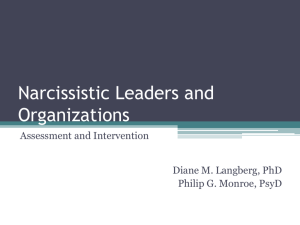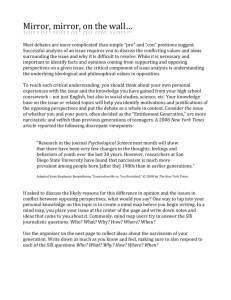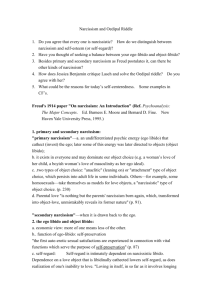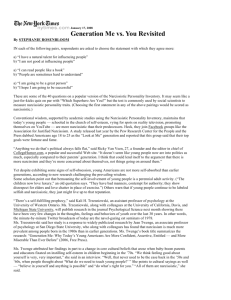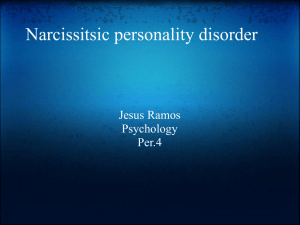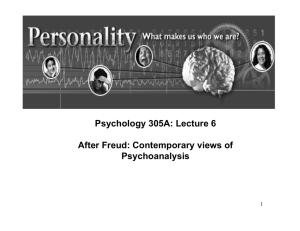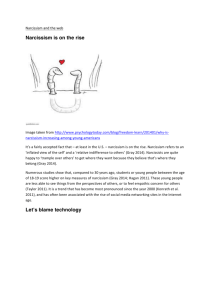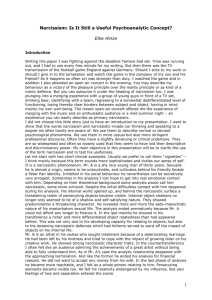Narcissistic Pathology as Understood in Tranference
advertisement
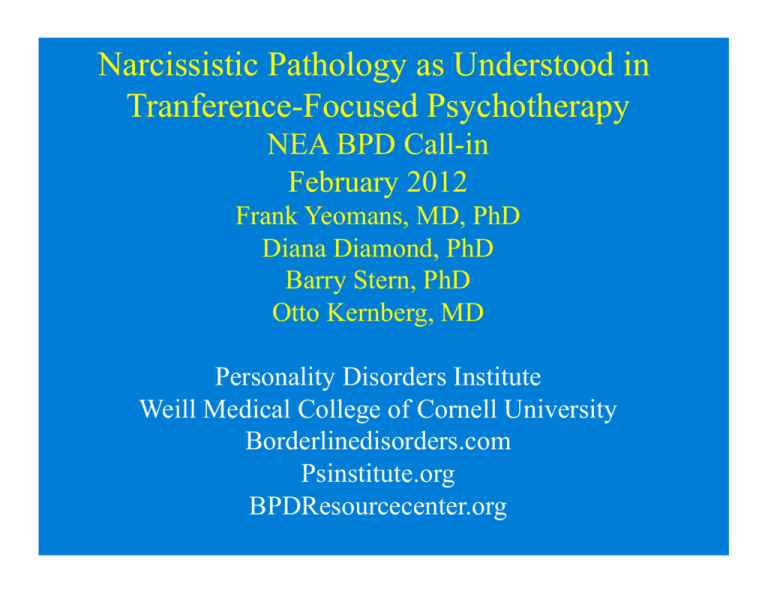
Narcissistic Pathology as Understood in Tranference-Focused Psychotherapy NEA BPD Call-in February 2012 Frank Yeomans, MD, PhD Diana Diamond, PhD Barry Stern, PhD Otto Kernberg, MD Personality Disorders Institute Weill Medical College of Cornell University Borderlinedisorders.com Psinstitute.org BPDResourcecenter.org Readings - 1 • Kernberg OF (1984). Severe Personality Disorders. New Haven, Yale University Press, chapters 11 to 14. • Kernberg OF (2004). Aggressivity, Narcissism & Self-destructiveness in the Psychotherapeutic Relationship. New Haven: Yale University Press. • Kernberg PF. Narcissistic Personality Disorder in Childhood. Psychiatric Clinics of North America. XII, 3, September 1989, 671-694. Readings - 2 • Diamond D, Yeomans FE, and Levy K Psychodynamic Psychotherapy for Narcissistic Personality Disorder. The Handbook of Narcissism and Narcissistic Personality Disorder: Theoretical Approaches, Empirical Findings, and Treatment, Eds. Keith Campbell and Josh Miller, New York: Wiley, 2011 • Stern BL, Yeomans FE, Diamond D, & Kernberg OF. (in press). Transference-Focused Psychotherapy (TFP) for Narcissistic Personality Disorder. In, Treating Pathological Narcissism, Ogrodniczuk, J., (Ed.). American Psychiatric Press: Washington, DC, 2011 IPDE Criteria for NPD 1. 2. 3. 4. 5. 6. 7. 8. 9. Grandiose sense of self importance Fantasies of success/power Believes self to be special and unique Requires excessive admiration Entitlement Interpersonally exploitative Lacks empathy Envious of others Shows arrogant, haughty behaviors/attitudes NPD/BPD: How are they related? • NPD and BPD share same level of structural intrapsychic organization – identity disturbances • The Grandiose Self characterizes NPD: – A condensation of everything that seems ideal and good, with the exclusion of anything negative – – It is a compensatory structure that is superimposed on fragmented internal world to provide a semblance of integration and stability to cover feelings of inadequacy and emptiness Narcissism: multiple meanings • Developmental phases/mental states: primary narcissism and secondary narcissism • A question of self esteem and how to manage it • A description of the state and quality of an individual’s object relations (capacity to invest in relations with others) Maintaining self-esteem - an internal affair • The individual’s relation to the ego ideal: internalized representations… fantasies… • The difference between the ego ideal and the real self (as perceived): how to manage the gap • The relation of this to BPD self-loathing/ self-hatred Maintaining self-esteem – cont’d • The gap can be in relation to self-representations: “I’d be happy with myself if I could be or do x, y, z….” “I loathe myself because I’m not what I think I should be.” • It can also be in relation to object representations… projections on others: “I’d be happy with myself if I lived up to his/her expectations of me.” “I loathe myself if I don’t.” • Therefore, the importance of – Distinguishing between self and other – Achieving integrated, realistic internal representations of self and other in one’s mind Another psychological issue at play • To experience and express one’s own aggression in a healthy way • The impact of aggression on objet relations. • Why talk about aggression? – A basic human affect/drive – It affects interpersonal relations – It can be experienced as envy in narcissism • What do we mean by aggression? Among other things, Self-acceptance includes: • Integrating one’s aggressive feelings in a healthy way • Managing the impact of aggression on object relations. What is healthy narcissism? • Appreciating one’s self with positive regard and loving feelings. This involves accurate appraisal of: – Success, creativity, accomplishment, ambition – Interpersonal relations, family, friends – The ability to satisfy one’s desires/drives – The ability to live in accord with one’s moral values and principles What is infantile narcissism? • The primitive infantile self passes through a narcissism based on gratification/satisfaction of needs, including the need to connect, to engage with the other • The adult with infantile narcissism: – Insatiable neediness – Incessant demandingness – But… the other exists for these individuals and they can tolerate dependency • Infantile narcissism is frequent in borderline patients What is pathological narcissism? - 1 • A specific personality disorder • The libidinal investing of a pathological self structure that is organized around a pathological grandiose self – which is a rigid self structure that serves as a defense – It involves idealized representations of self and other – It excludes the possibility of engaging in relations at a deep level – there is a chronic devaluing of others – “I don’t need anyone; I have/am everything that I need.” Pathological narcissism - 2 • The denial of dependency and refuge into omnipotence (which can lead to increasing isolation from the real world, since contact with others challenges that) • Intense envy; the solution is to not need the other. • The wish to be loved is transformed into the need to be admired. • Intense fear of being humiliated • Use others to satisfy one’s own needs Narcissism: Two Sides • Thick skinned vs. Thin skinned (Rosenfeld) A Diagnostic System for Narcissism within Borderline Personality Organization Fundamental Characteristics • Identity Diffusion vs. Integration (an internal sense of continuity) • No integrated concept of self – However, the narcissist can demonstrate a facsimile of integration • No integrated concept of others • Primitive defenses • Variable reality testing – Unrealistic sense of grandeur BPO: consequences and clinical implications • Non-specific weakness of the ego: poor impulse control and low anxiety tolerance • Unstable and disturbed interpersonal relations. Narcissists reject dependency and eliminate relations with others • A lack of engagement in work and love life. Severe narcissism: exploitation and the possibility of criminal acts. Feeling above rules and law. • Sexual Pathology (total inhibition or chaotic sex life) BPO: consequences and clinical implications … (cont’d) • Pathology of moral functioning • The destruction of time – especially in narcissists • With sharp midlife decline in functioning • Difficulty engaging the patient – Fragility of defenses – A devaluing Transference/countertransference Treatment: Reminder of the Theory that guides the Treatment • The concept of split internal psychological structure constitutes the principal source of identity diffusion and underlies borderline symptomatology Borderline Patient’s Internal World -S1 -a1 S = Self-Representation O = Object - Representation -O1 a = Affect Examples S1 = Meek, abused figure O1 = Harsh authority figure a 1 = Fear S2 = Childish-dependent figure O2 = Ideal, giving figure a2 = Love S3 = Powerful, controlling figure O3 = Weak, Slave-like figure a3 = Wrath +S2 . +a2 +O2 -O3 -a3 -S3 Etc. Narcissistic Psychopathology The Pathological Grandiose Self Object Representation Self Representation Contempt, Derision, Scorn (Fear, Suspicion) Grandiose (Self-sufficient) Depreciated, Devalued (Needy, Hostile, Envious) Narcissistic Psychopathology The Pathological Grandiose Self The Pathological Grandiose Self wards off a selfexperience of: - inferiority - aggression and hatred - envy - rejection - humiliation - incompetence Narcissistic Object Relations Dyad: Oscillation Object Rep Self-Rep Contempt, Derision Grandiose Self-sufficient Needs nothing Depreciated Devalued Nothing to offer Fear, Suspicion Depreciated Devalued Nothing to offer Arrogant Independent Superior One Narcissistic Object Relations Dyad Defending Against Another Dyad Surface Dyad Affect is Contempt Grandiose Self-sufficient Defended-against Dyad Dependent, perfectly nurtured self Negatively valenced, “persecutory” dyad Depreciated Devalued object Affect is Longing, Love Positively-valenced, “idealized” dyad Admiring, caring, Loving object The Goal: Normal Organization Transference-Focused Psychotherapy (TFP) with Narcissistic Pathology • The goal of TFP with narcissistic pathology: neutralization and dismantling of the Pathological Grandiose Self through the integration of the parts of the self that are split off • This is complicated by the tenaciousness of the defensive process reinforcing the Pathological Grandiose Self and the tremendous sensitivity to humiliation, shame, inferiority, submission Obstacles to TFP with Narcissistic Patients Treatment Contract • Patient’s defensive grandiosity often leads to - A retreat from life’s challenges - Feeling exempt from demands or obligations - A cavalier attitude toward treatment (why submit?) • Importance of addressing secondary gain - Patient may depend on social services or family - “Can not” vs. “will not” function • Managing suicidality / self-injury Technical Aspects: Adapt the therapy to the level of the pathology • The more serious the case, the more strict and fully developed is the frame • The more serious the case, the more interpretations will address the primary nature of the aggression (versus aggression as a defense against libidinal longings) • The more brittle the case, the more flexibility in the technique Principle Obstacle to Treatment with Narcissistic Patients • The alternative to the grandiose self is a sense of annihilation Obstacles to TFP with Narcissistic Patients: Interpretation • The content of interpretation – brings the patient into contact with that which he desperately needs to project and therefore is a threat to the Pathological Grandiose Self (resulting rage, omnipotent control) • Interpretation can be seen as an enactment of a cruel authority forcing the patient into a humiliating submission An attempt to address the obstacles: Therapist-centered interpretations Exploring the devalued object as it is perceived in the therapist may allow the patient to begin to reflect on this object without the catastrophic reaction that accompanies seeing it as part of the self This can help the patient observe and reflect on the devalued, dependent object – and on the associated aggression, as a step to bringing what is projected into their field of reflection Example As Therapy Progresses… The patient gradually experiences a conflict between his refuge into the false grandiose self and some awareness of “reality” The therapist often becomes the representative of reality; he/she becomes a bridge to a real alternative to the “exquisite” isolation The therapist must therefore have acute empathy for the pain and sense of humiliation involved in this process A Key Role of Reflective Functioning in Working with Narcissistic Patients Increasing RF – the capacity to reflect on his/ her mind and that of others - helps the patient see that the grandiose self is one mental state among others (which are difficult to bear). The patient may come to realize that the grandiose self is at the price of a real relation – which the therapist offers, within the frame
